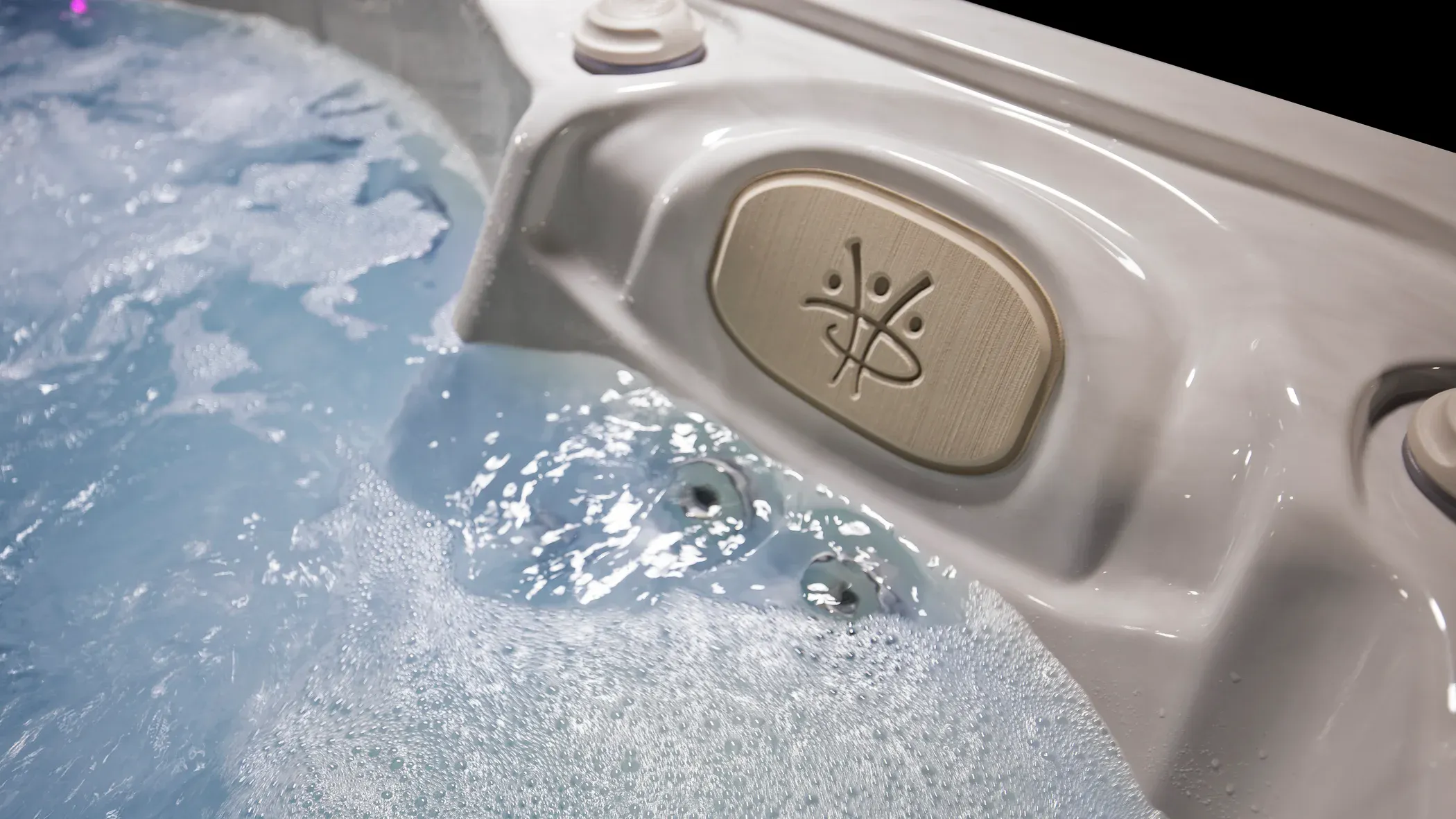A Complete Guide to Salt Water Hot Tubs

If you’re looking at hot tubs, at some point you’re going to hear about salt water hot tubs. Their appeal is instant. Salt water sounds more natural than using chemicals to clean water. If you’ve ever been in a salt water pool, you know the water can feel softer than other pools, smell better and even be less irritating to the skin.
Chemical usage is on every customer’s mind that buys a hot tub and at Hydropool, we’re very aware of that. Every hot tub company would love to have a chemical-free hot tub, and our engineers work on developing one as part of their regular jobs each day.
Here’s how our engineers look at ensuring your hot tub is clean: Hot tubs require filtration to remove particles from water and sanitization to remove bacteria. Sanitization is where salt water comes in, as salt acts as a sanitizer, which means it is killing off bacteria in the water.
But if it’s a natural product, and it’s effective in pools, so consumers are just left with questions:
- Why do only a few hot tub builders make salt water hot tubs?
- Why are there many salt water pools but not hot tubs?
- Is there another better system than salt water?
There are good answers to all these questions. We’re aware we are a company writing about our own product here, and we totally understand if you’re skeptical. Of course we’re going to say our system is the best, right?
In this case, we speak from experience: Hydropool made and sold salt water hot tubs for years, from about 2006 to 2019, before abandoning the method because we found a better way to reduce chemical usage. So did most of the hot tub industry. That’s why today very few salt water hot tubs are sold and few hot tub companies offer them.
Almost all of us think there’s a better way to do it. That’s why we wrote this article, so you could learn about salt water hot tubs, what’s good about them and what’s not, and what alternative systems are out there, so you could decide what’s right for you.
Hydropool’s Experience with Salt Water Hot Tubs: A Complete Guide
Hydropool made salt water hot tubs for more than a decade. We stopped because:
- we found them difficult for people to maintain, compared to other systems that reduce chemical usage
- additional hardware on the hot tubs often required more service, while alternate systems were more simple
- we developed another system featuring ozone and UV, which also significantly reduced chemical usage, but was far easier for customers to appreciate, that we sell to this day.
Ultimately, we found the salt water hot tubs to generally be more expensive for customers and harder to maintain. We’re not the only ones. The review website Wirecutter, which is owned by the New York Times, said in this article that “salt water systems are more expensive to maintain than UV and ozone.” Sadly, we have found that to be true (we now offer ozone and UV as a substitute for salt water, but more on that later).
Pros of Salt Water Hot Tub Systems
For anyone looking for natural solutions, salt water hot tubs are worth considering. Salt water pools are common, and their appeal is clear because salt water:
- Sounds like a natural product, which suggests less chemicals will be needed in the hot tub’s water. After all, we all want to swim in an ocean of salt water, right?
- Salt water sounds like it would be easier to maintain and possibly cheaper for an owner, as salt water should take care of any water sanitization.
- For many people, salt water is more gentle on their skin and doesn’t have the chemical-pool smell.
A Complete Explanation of How Salt Water Hot Tubs Work
Here’s the biggest surprise most people find when considering salt water hot tubs: while salt water cleans, no question, it actually does this by creating chlorine or bromine – which are usually the two chemicals people are trying to minimize. A salt water hot tub is actually a chlorine or bromine generating system.
Here’s how it works:
- Granulated salt is added to the water. It’s formulated for pools and spas and sold as sodium chloride or sodium bromide (which cannot be sold in Canada).
- The salt in the water is converted with an electrical current which transforms it into the chemical chlorine or bromine. This requires a separate piece of equipment running in the hot tub’s cabinet, which generates this current.
- The chlorine or bromine then behaves as chlorine or bromine typically behaves, attacking bacteria in your water. This is considered a reactive system because it can only attack bacteria that is already there.
- The end result is water that doesn’t even taste salty. The water is about 1/200th the salt level of the ocean, usually 1200 – 2000ppm.
- It's worth noting that salt water bromine was banned in Canada as of 2020 in some situations.
Common Issues with Salt Water Hot Tubs
- If using a salt water hot tub, your source water needs to be well balanced. There’s more work to keep your water in tune. With another type of hot tub, you just add more chlorine or bromine, but with a salt water tub, you need to add products and then wait for them to be activated in the water.
- You can’t have a large number of phosphates in your water, which is common in rural areas. Phosphates act as food for bacteria. In water with a lot of phosphates, your salt system will have a difficult time keeping pace with them.
- You need to have considerable patience: For example, you have to wait until the water is 80 degrees to add the salt. Then you need to wait until the salt converts enough salt into chlorine or bromine so your hot tub is becomes acceptable to use, which sometimes takes up to two days.
- If considering a salt water hot tub, we’d encourage you to ask for the maintenance manual before you buy. You’ll want to see the size of it and get a sense of the work you’ll need to do.
Why Does Salt Water Work in a Pool but Not (as well) in a Hot Tub?
This is largely due to the ratio of people to water and the amount of heat in a hot tub as opposed to a swimming pool.
- In a smaller body of water like a hot tub, the sanitization elements have a lot more work to do in less time than they do in a larger body of water. Essentially, the contaminant elements use up all the salt water cleaning elements. In a larger body of water, there are more cleaning elements compared to dirty elements and the water has more time to work as a result.
- Temperature is also a factor, as hot tubs are hotter than pools. Heat makes the sanitizer work harder, rendering it less effective.
- With a pool, the water has to circulate over an electrode. Pool salt cells last five years, but the pool isn’t being used. Pools only run for a few months.
- Hot tubs only use passive systems, while pools generally use a more dynamic system. To do a dynamic system with a hot tub, you’d need more equipment than you can put under the cabinet.
How Does Chlorine Work to Clean Your Hot Tub?
Chlorine is in our drinking water, and in doing so helps keep many diseases at bay. In your hot tub, it forms into acid when combined with the hydrogen and oxygen in water. Once it does that, it can kill bacteria at a tremendous rate, including types such as E.Coli and salmonella. For a deeper explanation of how chlorine works to kill bacteria, we’d suggest reading this article in Scientific American.
How Does UV and Ozone Work to Clean Your Hot Tub?
Some people don’t like chlorine or other cleaning elements like bromine. We totally understand that. Even though chlorine is in our drinking water, we know that many people increasingly prefer products that are natural.
Hydropool now uses a system that uses ozone and UV to treat its water, which are both natural products. Both of these are routinely used in hospitals or advanced drinking water systems to help purify water. The main difference from salt water is that UV and ozone together are an active system, not passive. It’s not attacking bacteria that’s already there, like a salt water hot tub does, but it inhibits the bacteria from ever developing.
- Whether it is salt water or ozone/UV, biofilm grows in your plumbing. Any time your water sits in the pipes, it can grow biofilm.
- UV and ozone render the bacteria cells unable to multiply and prevent the growth of biofilm. This is why it’s considered a proactive system.
- Chlorine is the backup solution for anything Pure Water misses. UV and Ozone are your main sources of cleaning in this system.
- The water is first oxidized by being exposed to ozone, which exposes any bacteria.
- The ozone-treated water then passes through a ultra-violet chamber, where it is exposed to a high volume of UVC light. That light zaps the ozone in the water, which in turn causes a reaction that purifies it by creating hydroxyl radicals. These hydroxyl radicals seek out substances to stabilize. Those substances are the contaminants in your water. By attaching to them, they cause the contaminants to break down. By doing so, they clean your water.
- The major benefit is an extreme reduction in chemicals. We generally have found customers who opt for the PureWater system, are able to use 50 per cent less chemicals than those who don’t.
- One catch with the Pure Water system is only on when your circulation pump is running. You are able to shut it on and off, because the bacteria has been made so it doesn’t reproduce. That’s why it’s able to be shut on and off.
A UV system is generally in the $700-$1000 range. At Hydropool it is standard on all Signature self-cleaning hot tub models, and optional on the Serenity hot tub collection.
Salt Water versus Ozone and UV: Which is best for me?
We are biased here, we know. We think ozone and UV are better for most people who are trying to reduce chemical usage in their hot tubs. But we are only saying this because we have had experience with both systems. We tried salt water hot tubs and did our best to engineer one that worked for customers. But we found that ongoing maintenance and performance issues – those hot tubs were just hard to look after and difficult to maintain – too often prevented customers from enjoying their hot tubs.
If you use your salt water hot tub only every couple of days, which allows it to catch up and sanitize your water, then a salt water system may be right for you.
That’s why we ultimately switched to the system we sell now, called Pure Water, which combines ozone and UV light to purify water, in much the same way our drinking water is treated.
Is this system right for you? If you have more questions about how we keep your hot tub water clean, don’t hesitate to reach out to us, by contacting a dealer near you.
- Want to design and build your dream hot tub? Click here.






